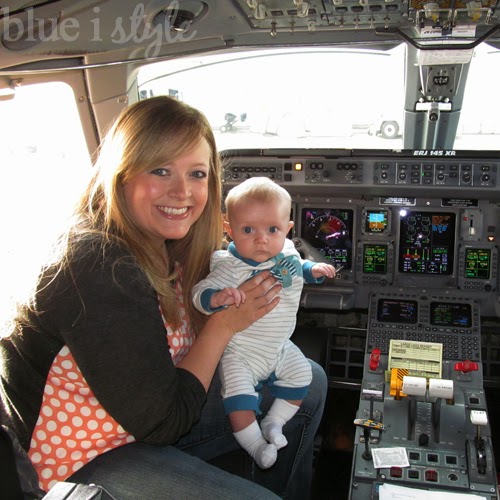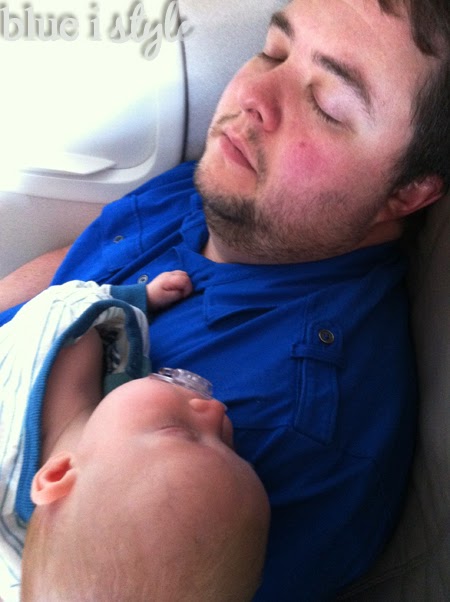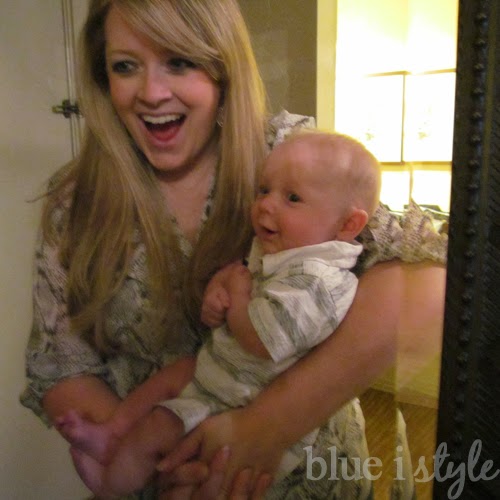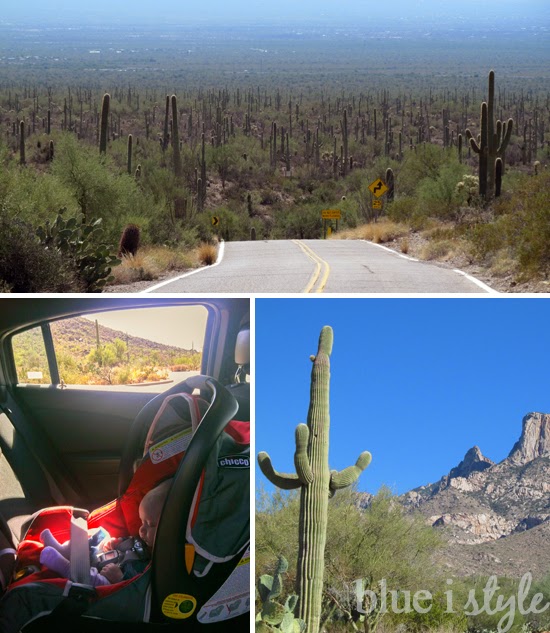A few weeks ago we flew to Tucson for a family wedding. This was our first time flying with Cooper, and he handled it like a champ! We flew with Beckett for the first time when he was about two months old, and had a successful flight with him as well, but we did learn a few lessons from that trip that made traveling with four month old Cooper even more stress-free.
Having taken two successful first plane trips with each of our boys by no means makes me a travel expert, but nonetheless I thought I would share 13 tips for flying and traveling with a baby for the first time. And why do I specifically refer to flying with baby for the first time? What about the second or third time? Well, the way I see it, once you’ve flown with your baby once, you become your own expert. You quickly discover what works for you and your baby and you make adjustments to your plans accordingly.
1. Making Plane Reservations
Each airline is different when it comes to making your reservations to travel with a baby. Most airlines allow babies and children under age 2 to fly for free when sitting in a parent’s lap, but you should confirm this in advance, and keep in mind that the rules are different for international flights. Some airlines make it very easy to book your flight with baby online – providing a place in the online reservation process to indicate that you will have a baby on your lap. Other airlines (like Southwest, for example) do not provide a place in the online process to indicate that there will be a baby traveling with you. When this is the case, it is important that you call the airline once you have booked your flight to notify them that a baby will be traveling with you, as they must ensure that the baby’s name is added to the flight manifest.
2. Bring a Copy of Baby’s Birth Certificate
Since your baby likely doesn’t have any other form of identification, you’ll need to bring a copy of baby’s birth certificate when flying domestically (internationally you’ll need a passport for baby). In my experience, they may or may not ask for the birth certificate when you check in for your flight with the airline, but the TSA will request it when you enter the security check point. Also be aware that some airlines may require a medical release if you are traveling with a newborn under 14 days old.
3. Do Your Research Regarding Baggage Fees for Baby Gear
As we all know, many airlines are doing away with the concept of free checked bags, but the rules and costs seem to be constantly changing. Knowing how many bags, if any, you can check free of charge, or how much you’ll have to pay for each additional bag, can help you decide how to pack for the trip. On our recent flight, we used our largest suitcase, and packed for my husband, Cooper, and myself all in one bag to avoid paying extra fees. This required some extra planning and consideration of what we really needed to bring for the baby, but in the end, it saved us quite a bit of money. Additionally, be aware that airlines often make exceptions for baby-gear, such as strollers and car seats, allowing these items to be checked at the counter or at the gate free of charge. Check with your airline in advance to determine what you’ll have to pay for and what you won’t.
4. Considerations Regarding Breastfeeding and Traveling with Breast Milk and Formula
If you are breastfeeding and typically use a Boppy or other nursing pillow at home, I can’t recommend highly enough the Boppy Travel Pillow! If you haven’t seen one of these before, it’s a very worthwhile purchase – I even keep mine in my car and use it anytime I’m away from home. The Boppy Travel Pillow folds in half and zips closed, has a carry-strap, and even has a zippered pocket that is perfect for holding a nursing cover. The carry-strap makes the Boppy Travel Pillow an easy carry-on item for the plane, saving valuable space in your luggage.
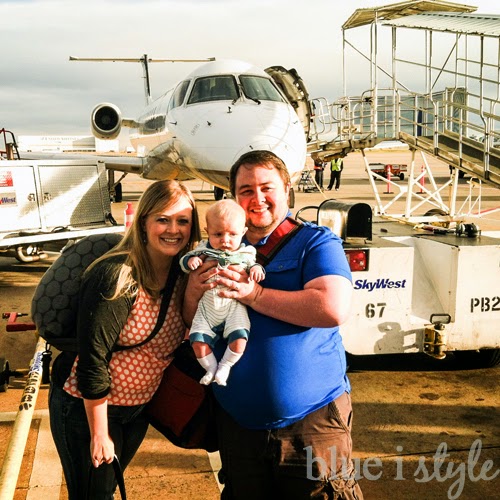 |
| That’s my Boppy Travel Pillow on my back. |
If you’ll be traveling with pumped breast milk, be sure to check the current TSA guidelines. At the time of this post, the TSA allows parents to carry breast milk (in quantities larger than three ounces) through security so long as it is presented for inspection at the checkpoint.
Formula can also be checked or carried through the security checkpoints. In my experience, however, the lids on most cans of formula don’t stay closed very well, making them a bit risky to travel with. Plus, if you are only supplementing with formula, you don’t necessarily need to take an entire can of formula for a short weekend trip. When preparing for our recent trip, we discovered the Similac On-the-Go Powder Singles. These are individually packaged 4 ounce tubes of powder that you simply tear open and pour into the bottle as needed. Traveling with these On-the-Go tubes of formula was so convenient. It was great being able to simply toss an empty bottle and one or two tubes of formula in to my purse each time we headed out for sight-seeing, knowing we’d be prepared if we needed a supplement.
5. Car Seat and Stroller Options
There are a lot of options when it comes to traveling with car seats and strollers. Many rental car companies have car seats available for rent, but I prefer to travel with our own car seat. Since neither of our kids have been old enough to sit in a regular stroller when we’ve traveled with them for the first time, we’ve opted to travel with our Chicco infant car seat and our Chicco Caddy (a light-weight frame that the car seat snaps onto, creating a stroller).
When traveling with your own infant car seat, you have a couple of options – bring the car seat base with you or leave the base at home. Our car seat is pretty easy to securely install without its base (using just a seat belt), so we have chosen to travel without our car seat base – one less thing to pack or check separately, one one less thing to lug through the airport on the other end. Just make sure you know how to install the car seat in your rental car when you arrive at your destination. Fortunately, it’s easy enough to pull up the installation instructions on your phone if need be.
Our Chicco Caddy is one of the baby items I don’t know how we’d live without – I use it daily, and it’s especially convenient when traveling with baby. Of course, if you don’t have a Chicco car seat, there are other brands of stroller frames out there compatible with a variety of car seats. Rather than checking the car seat and the stroller frame at the airline check-in counter, we used this stroller set-up to make our entire airport experience less stressful. Not only is it easier than carrying the baby through the airport, the large basket on the bottom of the stroller frame is also perfect for transporting your carry-on items to the gate. Then simply gate-check the car seat and the stroller frame, and they’ll be waiting for you at the gate when you arrive at your destination. A stroller base folds up much more compactly than most regular strollers, allowing it to fit easily in a rental car trunk. Best of all, as you travel, if the baby falls asleep in the car seat, you’ll be able to snap the car seat on to the stroller base without waking the baby.
6. Check In As Soon As You Arrive at Your Gate
As soon as you reach your gate, check in with the crew to let them know you are traveling with an infant. They may need to move your seats if you’ve been assigned to an exit row, or if your assigned seats are in a row that doesn’t have an extra oxygen mask for baby in case of emergency. Also let them know if you are gate checking a stroller or other baby gear. This is also a good time to politely ask if the airline offers priority boarding for families traveling with babies.
7. Keep Baby Awake At the Gate and Make Friends
It can be tempting to let the baby fall asleep while you are waiting at the gate, but the more baby sleeps before you board the plane, the less likely baby is to sleep on the plane. Instead, I recommend keeping the baby awake and entertained. Walk around and be friendly. Everyone loves a cute baby at the airport – but not everyone is thrilled to see a baby on the plane. Give people a chance to admire how cute you baby is while waiting at the gate, and you’ll be amazed at how much more understanding those same people will be once you’re on the plane.
8. Be Friendly to the Pilot and Crew While Boarding the Plane
Just like with the other passengers, it pays to be friendly to the pilot and the crew while boarding the plane. As we boarded our flight to Tucson, the cockpit door was open so we waved Cooper’s little hand and said hello. Right after we took our seats, we were approached by one of the flight attendants who brought Cooper a pair of wings (without us asking) and who invited us to sneak up to the cockpit for a quick photo before take off. What a cool keepsake for Cooper to have, a photo in the pilot’s seat from his first ever plane flight!
9. Consider Where to Sit on the Plane
Everyone will give you different advice regarding where to sit on the plane. Some people prefer to sit on the aisle, making it easy to get up and walk around with the baby if need be. I have read some who even advise that the parents should sit separately on the plane, allowing them to take turns with the baby while giving each other a break for portions of the flight. Scott and I, on the other hand, prefer to sit together and work as a team on the plane. We also prefer to take the window and middle seat – this ensures that when the baby (and the dad) falls asleep, the other person sitting in your row won’t feel trapped in and you won’t have to get up to let someone out, potentially waking the baby.
10. Feed the Baby On Take-Off and Landing
This is pretty common advice, but it bears repeating – feed the baby on take off and landing! On our flight home from Tucson, Cooper was one of four babies under a year old on the flight – and he was the only one who didn’t cry throughout the take off and the landing. Why, because he was eating. Babies’ ears are especially sensitive to pressure changes and sucking can help their ears to adjust. This is particularly true when the plane first begins to descend – that’s when you’re also most likely to feel the need to pop your own ears. If you are taking a relatively short flight (which is certainly easiest when traveling with an infant), you’ll have to control how much the baby eats on take-off to ensure that he or she will be ready and willing to eat again during the descent.
11. Ask the Hotel for a Pack & Play
Most hotels have pack & plays (playpens) available for the use of their guests. Call the hotel when you make your reservation to let them know that you’ll be staying with a baby and inquire what accommodations they have available. No matter how light weight and portable your pack & play may be, you can’t beat the convenience of not having to schlep it to and from the airport!
12. Make the Hotel Feel Like Home
Do what you can to make the hotel feel like home to your baby by sticking as closely as possible to your routine. If your baby sleeps in the same room as you at home, then make sure the pack & play is positioned where baby will be able to see you. If, on the other hand, the baby is used to sleeping in his or her own room, try to place the pack & play where the distractions to baby will be minimal. If baby is used to sleeping with a white noise machine, there is no need to pack this item for your trip. Just download a white noise app to your smartphone and place it near the pack & play at night. There are plenty of ways to entertain an infant in a hotel room without the need to bring lots of toys. Cooper loved being rolled around and bounced on the bed, and he was thrilled with the full length mirror!
13. Plan Sight-Seeing Drives Around Nap Time
We all know that nap time is vital, but it can be a challenge to work around naps when you are traveling. Rather than spending hours of your day sitting in the hotel room while the baby sleeps, consider planning some sight-seeing drives that correspond with nap time. Scott and I were able to enjoy some beautiful drives near Saguaro National Park (not in the park, sadly, due to the government shutdown) while Cooper slept soundly in his car seat.
Now I’d love to hear what tips you have. We’ve had good luck traveling with babies, but we haven’t yet ventured into the world of traveling with toddlers – so I’d especially love to hear your tips for flying with a toddler (or two toddlers)!

